Fan Kuan, Travelers by Streams and Mountains, act. 990-1020, Song Dynasty (6 3/4' X 2 1/2').
Painting in the Chinese tradition was an elite practice. The painters frequently came from important. Highly educated and steeped in Chinese culture, the painters were literati, or scholar-artists. They cultivated their talents in poetry, painting, calligraphy, and other arts as signs of their social status and refined knowledge. Frequently the painters were civil servants who explored their art as an altnerative to their bureaucratic responsibilities.
It would be interesting to compare a chinese landscape to the calendar landscapes of the TRH. Note how in the latter there is the clear dichotomy between nature and culture and there is also emphasis on ownership of land.s
Also compare the Chinese paintings to the Dürer artist drawing the nude.
The aim of traditional Chinese painting is to capture not only the external appearances but primarily to capture the essence or life force of what it represented.
Chinese painters regularly avoided color and reduced their paintings to shades of black and white.
Fan Kuan, Travelers by Streams and Mountains, act. 990-1020, Song Dynasty (6 3/4' X 2 1/2'). |
||
attributed to Qu Ding (active c. 1023-c. 1056), Summer Mountains. (17 7/8" X 45 3/8") (300 dpi image) |
|
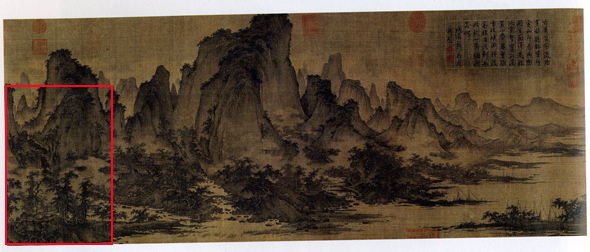 |
|
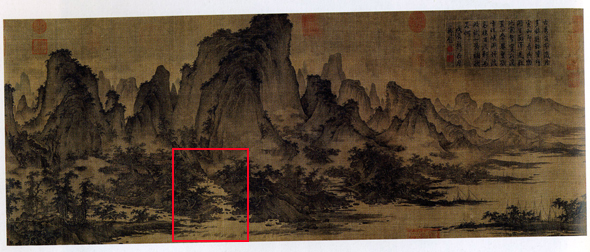 |
|
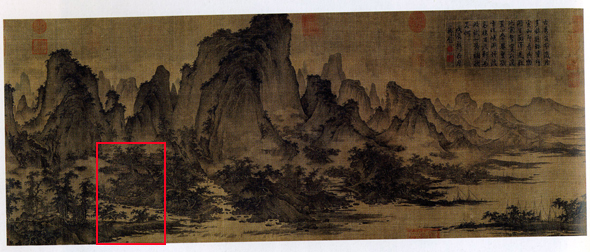 |
|
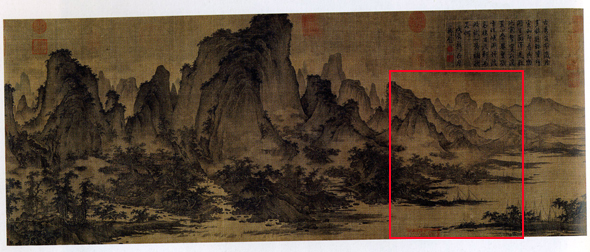 |
|
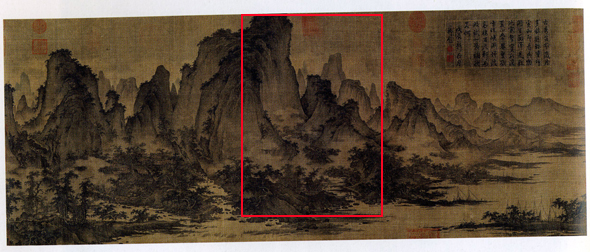 |
|
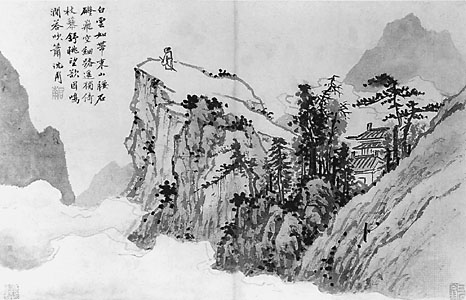 |
Shen Zhou, Poet on a Mountaintop, c, 1500, Ming Dynasty White clouds like a scarf enfold the mountain's waist; Stone steps hand in space ---a long, narrow path. Alone, leaning on my cane, I gaze intently at the scene, And feel like answering the murmuring brook with the music of my flute. |
Ni Zan (1306-1374), Wind among the Trees on the Riverbank, dated 1363 (23 1/4" X 12 1/4"). The paintings of Ni Zan focus on the same subject matter of a group of foreground trees and a view of distant mountains. Within this limited subject matter he explores the evocative affects of the landscape. The accompanying poem reads: On the riverbank the evening tide begins to fall; The frost-covered leaves of the windblown grave are sparse. I lean on my staff-- the brushwood gate is closed and silent; I think of my friends-- the glow is nearly gone from the hills. |
|
Ni Zan, Woods and Valleys of Mount Yu, dated 1372 (37 1/8" X 14 1/8"). Focusing on the same subject matter as the previous painting, observe the different evocative mood of the painting and poem in this work: We watch the clouds and daub with our brushes; We drink wine and write poems. The joyful feelings of this day Will linger long after we have parted. |
A General Introduction to Daoism in China
The Philosophical Taoism as Lao Tzu Professed
Stanford Encyclopedia of Philosophy entry for Taoism.
Introduction to literati paintings
Poem included on scroll by Lu Kuang (act. 2nd half of the 14th century), Alchemist's Terrace in the Dawn of Spring:
"For ten years in transient sojourns
I have shut myself out from the dusty business,
When I returned from the river
I have been yearning for a life of seclusion.
The emanation of jade floating in the air,
Spring season is devoid of rain;
The light of elixir is rising from the well
and forms the clouds in the morning.
In the breeze the dragon-headed staff
is to be leaned against--whenever necessary,
Yet under the moonlight the celestial music of the
phoenix-pipes is no longer heard--
from times immemorial.
How fortunate am I to be in the company
of a distant descendent of the old immortal,
Together we look at paintings,
Together we discuss literature."